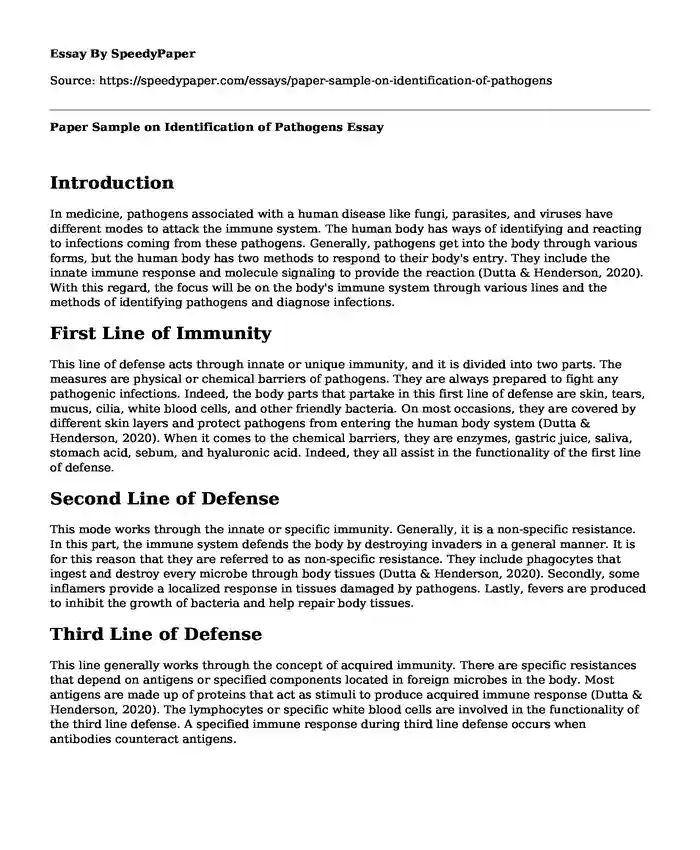Introduction
In medicine, pathogens associated with a human disease like fungi, parasites, and viruses have different modes to attack the immune system. The human body has ways of identifying and reacting to infections coming from these pathogens. Generally, pathogens get into the body through various forms, but the human body has two methods to respond to their body's entry. They include the innate immune response and molecule signaling to provide the reaction (Dutta & Henderson, 2020). With this regard, the focus will be on the body's immune system through various lines and the methods of identifying pathogens and diagnose infections.
First Line of Immunity
This line of defense acts through innate or unique immunity, and it is divided into two parts. The measures are physical or chemical barriers of pathogens. They are always prepared to fight any pathogenic infections. Indeed, the body parts that partake in this first line of defense are skin, tears, mucus, cilia, white blood cells, and other friendly bacteria. On most occasions, they are covered by different skin layers and protect pathogens from entering the human body system (Dutta & Henderson, 2020). When it comes to the chemical barriers, they are enzymes, gastric juice, saliva, stomach acid, sebum, and hyaluronic acid. Indeed, they all assist in the functionality of the first line of defense.
Second Line of Defense
This mode works through the innate or specific immunity. Generally, it is a non-specific resistance. In this part, the immune system defends the body by destroying invaders in a general manner. It is for this reason that they are referred to as non-specific resistance. They include phagocytes that ingest and destroy every microbe through body tissues (Dutta & Henderson, 2020). Secondly, some inflamers provide a localized response in tissues damaged by pathogens. Lastly, fevers are produced to inhibit the growth of bacteria and help repair body tissues.
Third Line of Defense
This line generally works through the concept of acquired immunity. There are specific resistances that depend on antigens or specified components located in foreign microbes in the body. Most antigens are made up of proteins that act as stimuli to produce acquired immune response (Dutta & Henderson, 2020). The lymphocytes or specific white blood cells are involved in the functionality of the third line defense. A specified immune response during third line defense occurs when antibodies counteract antigens.
Methods of Identifying Pathogens and Diagnose Infections
It involves identifying the causal agents of infectious diseases in the human body. Three steps are considered to identify and diagnose pathogenic infections. They involve sample collection, gauging microscopic and colonial morphotypes, and basing these activities on the bacteria's metabolic activities through automatic tests (Castro-Escarpulli, 2015). Indeed, it is the most common method used by physicians in checking for pathogenic infections. Various systems are used to make pathogens to be easily identified and be treated.
This method is used as an alternative for phenotypic methods. It involves the use of conserved sequences while maintaining phylogenetic targets like small-subunits. Generally, it entails the analysis of ribonucleic acid genes (Castro-Escarpulli, 2015). There is identifying differences in the genetic structure using biological assays and comparing it with various individual sequences in the body. Indeed, from here, one can know the level of infection in the body and deduce treatment mode.
Conclusion
These methods entail the use of antibodies by the antigens of pathogens in the body (Vazquez-Pertejo, 2020). A good analysis of antibody functions and the neutralization of pathogenic reactions' effect is done to check for the level of infections. Understanding the immune response reduces the impact and finds various treatment mechanisms of the viruses, bacteria, and fungi. It is the best mode because of the speed of analysis and production of solutions.
References
Castro-Escarpulli, G., Alonso-Aguillar, N. M., Sanchez, G. R., Bocanegra-Garcia, V., Guo, X., Juarez-Enriquez, S. R., et al. (2015). Identification and typing methods for the study of bacterial infections: a brief review and mycobacterial as case of study. Archives of Clinical Microbiology.
https://www.acmicrob.com/microbiology/identification-and-typing-methods-for-thestudy-of-bacterial-infections-a-brief-reviewand-mycobacterial-as-case-of-study.php?aid=7773#:~:text=Phenotypic%20identification,or%20automated%20tests%20%5B2%5D.
Dutta, S. S. & Henderson, E. (2020). What are the Three Lines of Defense?
https://www.news-medical.net/health/What-are-the-Three-Lines-of-Defense.aspx
Vazquez-Pertejo, M. T. (2020). Immunologic Tests for Infectious Disease. https://www.msdmanuals.com/professional/infectious-diseases/laboratory-diagnosis-of-infectious-disease/immunologic-tests-for-infectious-disease.
Cite this page
Paper Sample on Identification of Pathogens. (2023, Dec 25). Retrieved from https://speedypaper.net/essays/paper-sample-on-identification-of-pathogens
Request Removal
If you are the original author of this essay and no longer wish to have it published on the SpeedyPaper website, please click below to request its removal:
- Free Essay on Gandhi and His Selected Political Writings
- Munchausen by Proxy Cases, Free Essay in Psychology
- Free Essay on Abortion and Public Policy-Making
- Essay Example. Mechanisms of PDGFA-Driven Gliomagenesis
- Paper Example. Environmental Public Health Policy
- Essay Example on Argument Supporting the Banning of Smoking in Public Places
- Essay Sample on Inter-Professional Education: Enhancing Patient Care Through Team Collaboration
Popular categories





